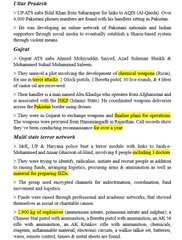Islamic terror module of doctors? From GMC Anantnag to Al Falah Hospital in Faridabad, a trail of weapons, 2,900 kgs of explosives and most disturbingly, doctors working for Jaish e Mohammad
https://www.opindia.com/2025/11/islamic ... -mohammad/
A shocking terror module involving doctors and professionals has been busted, revealing a white-collar network linked to Jaish-e-Mohammad and Ansar Ghazwat-ul-Hind. The discovery of nearly 2,900 kilograms of explosive material from two houses in Faridabad, just 45 kilometres from Delhi, has exposed one of the most sophisticated terror modules in recent years, one that operated under the unsuspecting cover of educated professionals.
Doctors turned terror operatives
The key accused, Dr Muzammil Shakil, a 35-year-old physician from Pulwama, and Dr Adeel Ahmad Rather, from Kulgam, were allegedly in direct contact with terror handlers in Kashmir and Pakistan. According to interrogation reports, both were awaiting final instructions for a major strike in the Delhi-NCR region.
The
handlers, sources say, specifically chose doctors believing “no one would suspect well-educated professionals in white coats.”
Investigators also revealed that both
doctors had earlier treated injured terrorists in Kashmir between 2018 and 2021. Their radicalisation was allegedly guided by a cleric named Molvi Irfan Ahmad, the imam of a mosque and a close associate of slain terrorist Zakir Musa.
The Kashmir connection: Posters and the first clues
The investigation began on
October 19, when police in Nowgam, Srinagar, discovered posters of Jaish-e-Mohammed threatening security forces. Surveillance footage led to the identification of Dr Adeel, who had been working at Government Medical College, Anantnag, before shifting to Saharanpur in Uttar Pradesh.
When Jammu and Kashmir Police traced and arrested him,
they found an assault rifle in his college locker, the first sign of how deeply radicalised professionals were embedded within civilian institutions.
Further leads from Adeel’s interrogation led authorities to Faridabad, where the trail widened dramatically.
Raids on Dr Muzammil’s two rented homes in Dhauj and Fatehpur Taga villages of Faridabad left investigators stunned. Over 350 kilograms of explosives, 20 timers, assault rifles, handguns, and ammunition were recovered from a house in Dhauj. In another recovery from a house in Fatehpur Taga, a staggering 2,563 kilograms of ammonium nitrate was found, a chemical commonly used in large-scale bombings.
In total, the two raids yielded nearly 2,900 kilograms of explosive material, including electronic circuits, wires, remote controls, batteries, and metal sheets, enough to assemble multiple powerful Improvised Explosive Devices (IEDs).
Police also recovered a Beretta pistol, a Chinese Star handgun, an AK-56 rifle, and an AK Krinkov rifle.
Faridabad ACP (Crime) Varun Dahiya confirmed that the Fatehpur Taga house had been rented from a maulana, who has since been detained for questioning.
The third doctor and the expanding network
During questioning, Dr Muzammil revealed that a colleague, Dr Shaheen Shahid, a woman doctor from Lucknow, had provided logistical support. When her Maruti Swift Dezire was searched, police found an AK-47 rifle and ammunition concealed inside.
Dr Shaheen was arrested and flown to Srinagar for interrogation, marking the third doctor arrested in this terror module.
With her arrest, the total number of people detained in the case has risen to eight, including Dr Muzammil Shakil (Pulwama), Dr Adeel Ahmad Rather (Kulgam), Dr Shaheen Shahid (Lucknow), Cleric Molvi Irfan Ahmad (Shopian), Arif Nisar, Yasir-ul-Ashraf, Maqsood Ahmad Dar, and Zameer Ahmad Ahanger (all from Srinagar and Ganderbal).
Pakistan’s shadow and encrypted channels
Investigators have traced the origins of this network to Pakistan, with operational instructions being relayed through handlers in Kashmir. The group used encrypted messaging apps for coordination, logistics, and fund transfers, often disguised as charitable donations or academic grants.
Jammu and Kashmir Police described the syndicate as a
“white-collar terror ecosystem”, comprising radicalised professionals and students who used their social credibility to recruit others, move funds, and procure materials for bomb-making.
A terrifying near miss
While investigators are still piecing together the exact plot, early interrogation hints suggest that the intended target was somewhere in the Delhi-NCR region, possibly designed to trigger communal unrest.
The
magnitude of the explosive cache, recovered barely an hour from the national capital, has triggered nationwide alarm. Senior security officials admit the plot could have caused devastation on an unprecedented scale, had it not been intercepted in time.
A new face of terrorism
This operation has jolted intelligence agencies into reassessing the
evolving face of terrorism in India, one that hides behind the respectability of degrees, stethoscopes, and professional credentials.
From Kashmir’s medical colleges to Delhi’s suburbs,
terrorism has changed its strategy. It has spiralled from conventional battleground into academic institutions and hospital corridors, where terrorists don’t wear battle fatigues but don lab coats and wield surgical instruments, waiting to no longer wears fatigues but lab coats.

